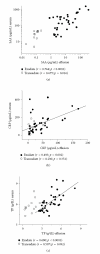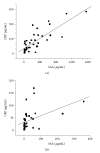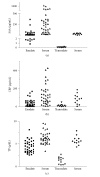The acute-phase proteins serum amyloid A and C reactive protein in transudates and exudates
- PMID: 16864904
- PMCID: PMC1570385
- DOI: 10.1155/MI/2006/47297
The acute-phase proteins serum amyloid A and C reactive protein in transudates and exudates
Abstract
The distinction between exudates and transudates is very important in the patient management. Here we evaluate whether the acute-phase protein serum amyloid A (SAA), in comparison with C reactive protein (CRP) and total protein (TP), can be useful in this discrimination. CRP, SAA, and TP were determined in 36 exudate samples (27 pleural and 9 ascitic) and in 12 transudates (9 pleural and 3 ascitic). CRP, SAA, and TP were measured. SAA present in the exudate corresponded to 10% of the amount found in serum, that is, the exudate/serum ratio (E/S) was 0.10 +/- 0.13. For comparison, the exudate/serum ratio for CRP and TP was 0.39 +/- 0.37 and 0.68 +/- 0.15, respectively. There was a strong positive correlation between serum and exudate SAA concentration (r = 0.764; p < 0.0001). The concentration of SAA in transudates was low and did not overlap with that found in exudates (0.02-0.21 versus 0.8-360.5 g/mL). SAA in pleural and ascitic exudates results mainly from leakage of the serum protein via the inflamed membrane. A comparison of the E/S ratio of SAA and CRP points SAA as a very good marker in discriminating between exudates and transudates.
Figures





Similar articles
-
Use of pleural fluid C-reactive protein in laboratory diagnosis of pleural effusions.Eur J Med. 1992 Jul-Aug;1(4):201-7. Eur J Med. 1992. PMID: 1341445
-
Use of acute phase proteins in pleural effusion discrimination.Tuberk Toraks. 2004;52(2):122-9. Tuberk Toraks. 2004. PMID: 15241695
-
Combined pleural fluid cholesterol and total protein in differentiation of exudates and transudates.Indian J Chest Dis Allied Sci. 2013 Jan-Mar;55(1):21-3. Indian J Chest Dis Allied Sci. 2013. PMID: 23798086
-
[Inflammatory reaction and laboratory tests: serum amyloid A (SAA) protein].Rinsho Byori. 1990 Mar;38(3):249-54. Rinsho Byori. 1990. PMID: 2112209 Review. Japanese.
-
C-reactive protein and serum amyloid A protein in neonatal infections.Scand J Infect Dis. 2000;32(3):229-35. doi: 10.1080/00365540050165848. Scand J Infect Dis. 2000. PMID: 10879591 Review.
Cited by
-
Amyloid A in Serum and Ascitic Fluid as a Novel Diagnostic Marker of Spontaneous Bacterial Peritonitis.Antiinflamm Antiallergy Agents Med Chem. 2020;19(2):140-148. doi: 10.2174/1871523018666190401154447. Antiinflamm Antiallergy Agents Med Chem. 2020. PMID: 30931865 Free PMC article.
-
C-reactive protein is not a useful indicator for infection in surgical intensive care units.Sao Paulo Med J. 2009 Nov;127(6):350-4. doi: 10.1590/s1516-31802009000600006. Sao Paulo Med J. 2009. PMID: 20512289 Free PMC article.
-
Simplified Light's Criteria and Acute Phase Proteins Reflect Aetiology of Feline Body Cavity Effusions Better than the Traditional Classification Scheme.Animals (Basel). 2023 Jun 8;13(12):1918. doi: 10.3390/ani13121918. Animals (Basel). 2023. PMID: 37370428 Free PMC article.
-
Serum amyloid A levels in acute and chronic urticaria.An Bras Dermatol. 2019 Oct 17;94(4):411-415. doi: 10.1590/abd1806-4841.20197761. eCollection 2019. An Bras Dermatol. 2019. PMID: 31644612 Free PMC article.
-
Serum amyloid A induces reactive oxygen species (ROS) production and proliferation of fibroblast.Clin Exp Immunol. 2011 Mar;163(3):362-7. doi: 10.1111/j.1365-2249.2010.04300.x. Epub 2010 Dec 22. Clin Exp Immunol. 2011. PMID: 21175596 Free PMC article.
References
-
- Gabay C, Kushner I. Acute-phase proteins and other systemic responses to inflammation. The New England Journal of Medicine. 1999;340(6):448–454. - PubMed
-
- Upragarin N, Landman WJ, Gaastra W, Gruys E. Extrahepatic production of acute phase serum amyloid A. Histology and Histopathology. 2005;20(4):1295–307. - PubMed
-
- Castell JV, Gomez-Lechon MJ, David M, Fabra R, Trullenque R, Heinrich PC. Acute-phase response of human hepatocytes: regulation of acute-phase protein synthesis by interleukin-6. Hepatology. 1990;12(5):1179–1186. - PubMed
-
- Nakayama T, Sonoda S, Urano T, Yamada T, Okada M. Monitoring both serum amyloid protein A and C-reactive protein as inflammatory markers in infectious diseases. Clinical Chemistry. 1993;39(2):293–297. - PubMed
-
- Lannergard A, Larsson A, Kragsbjerg P, Friman G. Correlations between serum amyloid A protein and C-reactive protein in infectious diseases. Scandinavian Journal of Clinical and Laboratory Investigation. 2003;63(4):267–272. - PubMed
Publication types
MeSH terms
Substances
LinkOut - more resources
Full Text Sources
Research Materials
Miscellaneous

